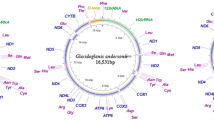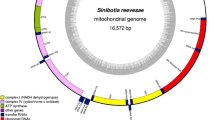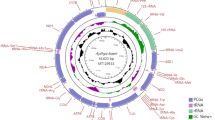Abstract
The phylogenetic relationships within the genus Takifugu Abe, 1949 (Tetraodontiformes, Tetraodontidae) remain unresolved. Because of the use of Takifugu as model organisms, the resolution of these relationships is crucial for the interpretation of evolutionary trends in biology. Pufferfishes of this genus are comprised of a comparatively small number of species and are mainly distributed along the coastal region of the western part of the Sea of Japan and the coastline of China. Mitochondrial gene sequences were employed to test the phylogenetic hypotheses within the genus. Seventeen species of the genus were examined. Molecular phylogenetic trees were constructed using the maximum parsimony, neighbor-joining, maximum likelihood and Bayesian methods. Our hypothesis of internal relationships within the genus differs from previous hypotheses. Our results indicate that (1) the genus Takifugu is a monophyletic assemblage; (2) the genus is divided into 6 subgroups based on the molecular data; and (3) there is low genetic diversity among the species within this genus. In addition, speciation within Takifugu appears to be driven by hybridization and isolation by distribution. Our results also suggested that the taxonomy in the genus should be clarified based on both molecular and morphological data.
Similar content being viewed by others
References
Su J, Li C. Fauna Sinica, Class Teleostei, Tetraodontiformes. Beijing: Science Press, 2002
Santini F, Tyler J C. A phylogeny of the families of fossil and extant tetraodontiform fishes (Acanthomorpha, Tetraodontiformes), upper cretaceous to recent. Zool J Linnean Soc, 2003, 139(4): 565–617
Masuda H, Amaoka K, Araga C, et al. The Fishes of the Japanese Archipelago, vol. Text and Plates. Tokyo: Tokai Univ Press, 1984
Song L, Liu B, Xiang J, et al. Molecular phylogeny and species identification of pufferfish of the genus Takifugu (Tetraodontiformes, Tetraodontidae). Mar Biotechnol (NY), 2001, 3(4): 398–406
Cheng Q, Wang C, Tian M, et al. Studies on the Chinese Tetraodonoid fishes of the genus Fugu. Acta Zool Sin (in Chinese), 1975, 21(4): 359–378
Miyaki K, Tebeta O, Kayano H. Karyotypes in six species of pufferfishes genus Takifugu (Tetraodontidae, Tetraodontiformes). Fish Sci, 1995, 61: 594–598
Wang K, Zhang P, Yin Q. Studies on the interspecific differences of myogen and cluster of the genus Fugu. Ocean Limnol Sin (in Chinese), 1984, 15(5): 493–500
Fraser-Brunner A. Notes on the plectognath fishes. VIII. The classification of the suborder Tetraodontoidea, with a synopsis of the genera. Ann Mag Nat Hist, 1943, 10(61): 1–18
Abe T. Taxonomic studies on the puffers (Tetraodontidae, Teleostei) from Japan and adjacent regions, V: Synopsis of the puffers from and adjacent regions. Bull Biogeogr Soc Japan, 1949, 14(1, 13): 1–15, 89–140, 141–142
Abe T. Taxonomic studies on the puffers (Tetraodontidae, Teleostei) from Japan andadjacent regions, VII: Concluding remarks, with the introduction of two new genera, Fugu and Boesemanichthys. Jpn J Ichthyol, 1952, 2(1, 2, 3): 35–44; figs. 31–33, 93–97, 117–127
Whitley G P. Studies in ichthyology, vol 16. Records of the Australian Museum, 1953
Chen C, Shi T, Sun S G, et al. Identification a phylogenetic relationships among four species of puffer fish in Fugu as determined by RAPD markers. Marine Fish Res (in Chinese), 2001, 22(3): 32–36
Song L, Li H, Cui Z, et al. Population genetic structure and genetic differentiation of the pufferfish Takifugu rubripes and Takifugu pseudommus revealed by RAPD Analysis. High Technol Lett, 2003, 9(1): 22–25
Song L S, Liu B, Wang Z, et al. Phylogenetic relationships among pufferfish of genus Takifugu by RAPD analysis. Chin J Oceanol Limnol, 2001, 19(2): 128–134
Aparicio S, Chapman J, Stupka E, et al. Whole-genome shotgun assembly and analysis of the genome of Fugu rubripes. Science, 2002, 297(5585): 1301–1310
Elmerot C, Arnason U, Gojobori T, et al. The mitochondrial genome of the pufferfish, Fugu rubripes, and ordinal teleostean relationships. Gene, 2002, 295(2): 163–172
Brenner S, Elgar G, Sandford R, et al. Characterization of the pufferfish (Fugu) genome as a compact model vertebrate genome. Nature, 1993, 366(6452): 265–268
Chen W J, Orti G, Meyer A. Novel evolutionary relationship among four fish model systems. Trends Genet, 2004, 20(9): 424–431
Holcroft N I. A molecular test of alternative hypotheses of tetraodontiform (Acanthomorpha: Tetraodontiformes) sister group relationships using data from the RAG1 gene. Mol Phylogenet Evol, 2004, 32(3): 749–760
Holcroft N I. A molecular analysis of the interrelationships of tetraodontiform fishes (Acanthomorpha: Tetraodontiformes). Mol Phylogenet Evol, 2005, 34(3): 525–544
Esposti M D, De Vries S, Crimi M, et al. Mitochondrial cytochrome b: Evolution and structure of the protein. Biochim Biophys Acta, 1993, 1143(3): 243–271
Miya M, Nishida M. Use of mitogenomic information in teleostean molecular phylogenetics: A tree-based exploration under the maximum-parsimony optimality criterion. Mol Phylogenet Evol, 2000, 17(3): 437–455
Zardoya R, Meyer A. Phylogenetic performance of mitochondrial protein-coding genes in resolving relationships among vertebrates. Mol Biol Evol, 1996, 13(7): 933–942
Peng Z, He S, Zhang Y. Phylogenetic relationships of glyptosternoid fishes (Siluriformes: Sisoridae) inferred from mitochondrial cytochrome b gene sequences. Mol Phylogenet Evol, 2004, 31(3): 979–987
Cui J, Shen X, Yang G, et al. Genetic diversities of T. rubripes and T. pseudommus determined by microsatellites DNA variations. High Technol Commun, 2005, 15(12): 90–96
Sambrook J, Fritsch E F, Maniatis T. Molecular Cloning: A Laboratory Manual-2nd. New York: Cold Spring Harbor Laboratory Press, 1989
Xiao W, Zhang Y, Liu H. Molecular systematics of Xenocyprinae (teleostei: cyprinidae): Taxonomy, biogeography, and coevolution of a special group restricted in East Asia. Mol Phylogenet Evol, 2001, 18(2): 163–173
Liu H Z. Phylogenetic relationships of the cypriniformes tested by mtDNA 12S rRNA sequence variations. Acta Genet Sin, 2004, 31(2): 137–142
Thompson J D, Gibson T J, Plewniak F, et al. The CLUSTAL_X windows interface: Flexible strategies for multiple sequence alignment aided by quality analysis tools. Nucleic Acids Res, 1997, 25(24): 4876–4882
Galtier N, Gouy M, Gautier C. SEAVIEW and PHYLO_WIN: Two graphic tools for sequence alignment and molecular phylogeny. Comput Appl Biosci, 1996, 12(6): 543–548
Wiens J J. Combining data sets with different phylogenetic histories. Syst Biol, 1998, 47(4): 568–581
Farris J S, Kallersjo M, Kluge A G, et al. Testing significance of incongruence. Cladistics, 1995, 10(3): 315–319
Swofford D L. PAUP*. Phylogenetic Analysis Using Parsimony (*and other methods), 4th ed. Sunderland, Massachusetts: Sinauer Associates, 2002
Tamura K, Nei M. Estimation of the number of nucleotide substitutions in the control region of mitochondrial DNA in humans and chimpanzees. Mol Biol Evol, 1993, 10(3): 512–526
Xia X, Xie Z. DAMBE. Software package for data analysis in molecular biology and evolution. J Hered, 2001, 92(4): 371–373
Guo X, He S, Zhang Y. Phylogeny and biogeography of Chinese sisorid catfishes re-examined using mitochondrial cytochrome b and 16S rRNA gene sequences. Mol Phylogenet Evol, 2005, 35(2): 344–362
Irwin D M, Kocher T D, Wilson A C. Evolution of the cytochrome b gene of mammals. J Mol Evol, 1991, 32(2): 128–144
Farris J S. Methods for computing Wagner trees. Syst Zool, 1970, 19(1): 83–92
Felsenstein J. Evolutionary trees from DNA sequences: A maximum likelihood approach. J Mol Evol, 1981, 17(6): 368–376
Mau B. Bayesian phylogenetic inference via Markov chain Monte Carlo methods. Madison: University of Wisconsin-Madison, 1996
Huelsenbeck J P, Ronquist F. MRBAYES: Bayesian inference of phylogenetic trees. Bioinformatics, 2001, 17(8): 754–755
Felsenstein J. Confidence limits on phylogenies: an approach using the bootstrap. Evolution, 1985, 39(4): 783–791
Posada D, Crandall K A. MODELTEST: Testing the model of DNA substitution. Bioinformatics, 1998, 14(9): 817–818
Lanave C, Preparata G, Saccone C, et al. A new method for calculating evolutionary substitution rates. J Mol Evol, 1984, 20(1): 86–93
Kumar S, Tamura K, Nei M. MEGA3: Integrated software for Molecular Evolutionary Genetics Analysis and sequence alignment. Brief Bioinform, 2004, 5(2): 150–163
Templeton A R. Phylogenetic inference from restriction endonuclease cleavage site maps with particular reference to the evolution of humans and the apes. Evolution, 1983, 37(2): 221–244
Shimodaira H, Hasegawa M. Multiple comparisons of loglikelihoods with applications to phylogenetic inference. Mol Biol Evol, 1999, 16(8): 1114–1116
Cantatore P, Roberti M, Pesole G, et al. Evolutionary analysis of cytochrome b sequences in some Perciformes: Evidence for a slower rate of evolution than in mammals. J Mol Evol, 1994, 39(6): 589–597
Lydeard C, Roe K J. The Phylogenetic Utility of the Mitochondrial Cytochrome b Gene for Inferring Relationships Among Actinopterygian Fishes. San Diego: Academic Press, 1997
Buckley T R, Simon C, Shimodaira H, et al. Evaluating hypotheses on the origin and evolution of the New Zealand alpine cicadas (Maoricicada) using multiple-comparison tests of tree topology. Mol Biol Evol, 2001, 18(2): 223–234
Masuda Y, Shinohara N, Takahashi Y, et al. Occurrence of natural hybrid between pufferfishes, Takifugu xanthopterus and T. vermicularis, in Ariake Bay, Kyushu, Japan. Nippon Suisan Gakkaishi, 1991, 57(7): 1247–1255
Johnson J B, Jordan S. Phylogenetic divergence in leatherside chub (Gila copei) inferred from mitochondrial cytochrome b sequences. Mol Ecol, 2000, 9(8): 1029–1035
Near T J, Porterfield J C, Page L M. Evolution of Cyt b and the molecular systematics of Ammocrypta (Percidae: Etheostomatinae). Copeia, 2000, 3: 701–711
Kadereit J W. Molecules and morphology, phylogenetics and genetics. Bot Acta, 1994, 107: 369–373
Author information
Authors and Affiliations
Corresponding author
Additional information
Supported by the National Natural Science Foundation of China (Grant No. 30225008)
About this article
Cite this article
Zhang, Y., He, S. Investigations into the perplexing interrelationship of the Genus Takifugu Abe, 1949 (Tetraodontiformes, Tetraodontidae). Chin. Sci. Bull. 53, 233–244 (2008). https://doi.org/10.1007/s11434-008-0066-2
Received:
Accepted:
Issue Date:
DOI: https://doi.org/10.1007/s11434-008-0066-2




